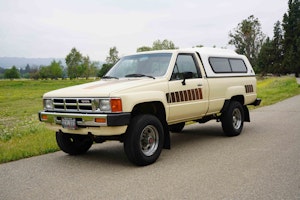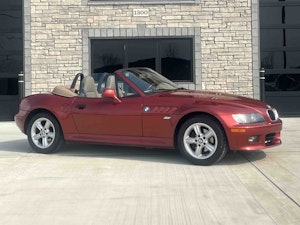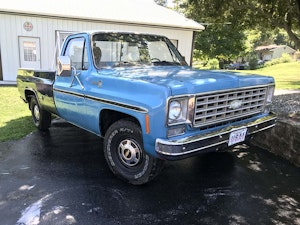Media | Articles
The joy of owning a mid-rise lift
After my lengthy and emotionally-draining three-part series on my dead Lotus Europa, something simple, useful, and, uh, uplifting is in order.
20171113171523)
Like any car nut, I badly wanted to have a lift in my garage. But first, I badly wanted a garage. For 15 years I lived with a World War II-era, corrugated metal, rusting, leaning, one-car garage with illumination courtesy of a single drop light powered by an extension cord a ran from the house. When I finally had my new garage built in 2005, the good news was that it could hold as many as four cars if I packed them in two wide and two deep. The bad news was that, to respect the setback in the zoning laws of my town, the garage needed to be attached to the back of my house, and that greatly influenced the kind of lift I could have.
The word “lift” used to conjure up an image of an old-school single-piston unit with one massive hydraulic piston that sank into a cylinder in the floor. These used to be the norm in service stations and have the advantage of nearly vanishing when recessed. But they fell out of favor due to the installation cost, potential maintenance issues, and lack of mobility. Post lifts took their place—four-post lifts and two-post lifts. For the most part, four-post lifts have ramps between the front and back sets of posts, which allow the vehicle to be driven on and raised, thereby allowing easy stacking of vehicles for storage. However, they require the wheels to be on the car. Most four-post lifts are self-supporting and do not need to be anchored.
Marketplace
Buy and sell classics with confidence
20171113170320)
In contrast, two-post lifts need to be secured at the bottom (that is, anchored to the concrete floor) and, depending on the model, possibly the top as well. Rather than drive-on ramps, they have arms that are extended beneath the vehicle to pick it up by its jacking points. The huge advantage of a two-post lift is that, like a four-post, it leaves the area under the vehicle completely open, allowing you to walk beneath it and access the entire undercarriage. And unlike a four-post with drive-on ramps, it allows wheels-off repair work.
20171113171257)
There are also non-post lifts usually categorized as low-rise and mid-rise. These pick a car up approximately 28 inches and 48 inches, respectively. While some have ramps and are used for things such as oil changes, most are without ramps and are used in establishments, like tire shops, that need to get wheels on and off quickly but don’t routinely require unimpeded access to the vehicle’s undercarriage.
Let me add that this is far from an exhaustive summary of lift options. There are also the issues of whether the lifts are direct, pulley, or hydraulic drive, symmetric or asymmetric, and whether or not they’re certified by the American Lift Institute (ALI).
It initially seemed that, for my new garage, choosing a two-post lift was a slam-dunk. It would accommodate all of my automotive work—wheels-off repair plus the siren’s song of allowing a transmission jack to be rolled beneath the vehicle for clutch or transmission work. Plus it would allow me to stack cars in the garage. Who wouldn’t want that giant Swiss Army knife?
Unfortunately, my garage has a nine-foot ceiling. This was necessary because, having the garage attached to the back of the house, my wife, Maire Anne, and I didn’t want it to block the windows in the dining room. When the garage was built 12 years ago, the short ceiling height appeared to prevent the selection and installation of a post lift. Today, there do appear to be some short-height post lift options for a nine-foot ceiling, particularly if you cut into the ceiling and let the posts go into it, though there’s still not enough ceiling height to be able to stack anything but two Lotus Europas. In addition, there is an 89-inch-high bottom-only-anchored two-post solution (google “MaxJack”). But at the time, my only option appeared to be mid-rise lifts. Resigned and disappointed, I began investigating them.
Mid-rise lifts, also sometimes referred to as scissors lifts (though don’t confuse them with the scissors lifts that are meant to raise a person up to the ceiling of a warehouse) are basically like a big floor jack that pick up the entire car. Most mid-rise lifts, when fully extended, can pick a car up four feet, some a bit more. As the “scissors” label implies, they’re configured like an “X” with a platform on the top. They lay flat on the floor, allowing a car to be parked over them (more on that in a moment). The lift has arms that you then extend into place beneath the jacking points of the car. A pair of hydraulic cylinders draws one set of the lift’s legs toward the platform, raising it up. One pair of legs stays put on the floor; the other pair moves inward via metal wheels on the bottom. The hydraulic cylinders are driven by an electric pump that’s on a stand (it looks similar to a golf bag). The lift has a series of mechanical stops, and a latch you throw to engage one of them. On most inexpensive mid-rise lifts, the stops are at one-foot intervals. You raise the lift above the stop, manually throw the latch, then set it down onto the stop.
20171113165955)
My initial disappointment notwithstanding, the benefits of the mid-rise lift are substantial. Four feet of height may not sound like a lot, but it is enough to be able to sit on your butt fully upright beneath the car. I can tell you that, after years of contorting myself beneath cars, this alone is nothing short of bliss.
Their low cost is certainly appealing. I believe that I paid $1,450 for my BendPak MD6XP 10 years ago, delivered. The price has gone up since then, but there are many other mid-rise lifts in the $1,200–$1,700 range.
Another advantage of the mid-rise is its compact form factor. While post lifts leave the underside of the car completely open, that feature doesn’t come for free. It’s not like it’s levitating the car. The lifting mechanism—the posts—are on the sides. If you have a huge garage, or only one car, or have the lift outside, that may be fine, but in a confined garage like mine, the posts would occupy so much space that it would be difficult to park another car next to it.
Next, a mid-rise lift requires zero installation. None. It shows up at your house on a palette. You simply slide it into position, fill the pump reservoir with fluid, plug it in, and hit the button. There is no need to anchor it to the floor. And after you try it, if you think you might want it in a different spot, it can be moved around in the garage fairly easily. The golf bag-like hydraulic pump and stand has wheels and a pin at the bottom. It’s designed so that you can hook the pin under one end of the lift, lever it up, and roll the lift using the wheels at the ends of its legs. In practice, I’ve found it easier to simply take a long crowbar and shove the thing eight inches at a time along the garage floor. In either case, it’s easy to move; I had my lift in two other places in my garage before I settled on the best location.
The mid-rise has an interesting unintended benefit as well. While you can’t use it to stack cars vertically, you can tuck the nose of one car under another. My garage is 31 feet long. That means that little cars, like my BMW 2002s or Z3 M Coupe, will easily fit nose-to-tail, but longer cars won’t. With one car up on the lift, that constraint vanishes, however, and I can keep the cars out of the weather and work on them as well.
20171113171133)
There is the minor annoyance of needing small “ramps” (long mini-platforms with ramped fronts) on both sides of the lift to get extra clearance for the car. When folded flat, the height of a mid-rise lift is about five inches. On a low car like my departed Porsche 911SC or my BMW Z3 M Coupe, you definitely need some extra height to clear the lift, but even on higher cars, the ramps are useful because they provide the visual cues you need in order to drive the car, centered, over the lift. Plus, on my BendPak, the locking latch sticks up maybe another inch, acting like a little can opener to catch an exhaust resonator if you’re careless; the ramps eliminate that concern. Many people make their own ramps by stacking and gluing a few pieces of staggered shelving boards, or by cutting the ends off a bunch of 2x4s, arraying them side-by-side, and gluing or cross-bolting them together.
20171113171401)
One thing that you may read about mid-rise lifts is that while they’re great for work around the wheels, such as brake or suspension work, they’re problematic for repairs under the car, particularly in the center of the car, like exhaust or transmission work, because the body of the lift itself is in the way. Long story short, unless you’re pulling a transmission, it’s a minor issue.
The mid-rise is great for any work under the front or back of the car because the car overhangs the body of the lift. There is nothing in the way of the engine or the differential. When I still had my Porsche 911SC, I used the mid-rise to pick up the car and combined it with an inexpensive lift table to drop the engine. Compared with the DIY Porsche engine-drop technique of setting the car on tall jack stands and dropping the engine using a high-lift jack, it almost wasn’t fair.
The mid-rise is fine for most work in the center of the car because the body of the lift is not solid. You can easily crawl under the platform and between the legs, and position yourself directly under the transmission or the driveshaft or exhaust components in the middle of the car. I dropped an exhaust and a driveshaft on mine just the other night. Sure, it’s not as good as a post lift where nothing is in the way, but most of the time, it’s really not a problem. The only exceptions to this have been when I’ve changed fuel filters in some of my BMWs, where the filter is under the car between the door and the frame rail. There, the platform of the lift really is in the way, but it’s no worse than having the car on the ground, and with it up on the lift, at least I can do it while sitting on my backside.
Where there is a problem is when removing a transmission. I no longer have the upper body strength of a young man, and I rely on a transmission jack (or floor jack with a transmission cradle) to remove or install a transmission. This requires rolling a transmission into place, lifting it, aligning it, and sliding the input shaft into the clutch splines. You can easily reach the transmission with the car on a mid-rise lift, but unfortunately, the body of the lift is in the way of where you’d need to position a transmission jack. Specifically, while every mid-rise lift I’ve ever seen has a cut-out on one end of the platform to allow easy access to the underside of the engine and the transmission, directly beneath that cut-out are the hydraulic lifting cylinders, so you can’t simply roll a transmission jack beneath the cut-out.
20171113170736)
20171113170707)
There are a few ways around this. At the other end of the lift, there is neither an access cut-out on the platform nor the hydraulic lifting cylinders beneath it. Instead, there is just the cross-member connecting the two legs. It is possible to take two old rims, place wood or metal sheet over them to make a floor, and roll a transmission jack over it. I’ve also mounted a jack on a wheeled platform that extended over the cross-member. Because this end of the platform doesn’t have the cut-out, you have to pay close attention to the clearance between the back of the transmission and the non-cut-out part of the platform. It’s a little tricky, but I’ve done it.
20171113171742)
20171113171851)
Another trick is to use the end of the lift that has the cut-out and the hydraulic cylinders, and build a little stage using two milk crates on each side and a thick plywood board supported in the middle so it won’t sag. What you’re trying to do is lift a transmission jack high enough so you can move it far enough back that it’s under the transmission without hitting the hydraulic cylinders. In order to provide fore-and-aft motion to maneuver the transmission, I’ve positioned a lift table in front of the board. This all works—it lets you get a transmission jack into position—but the downsides are substantial. It’s not terribly stable, and you need a friend’s help to lift both the jack and the transmission on and off the board, at least I do.
20171113170845)
20171113170951)
Because of these difficulties, over time I’ve adopted the following simple technique when I need to remove a transmission: I put the car up on the mid-rise lift, and with it up there, remove everything—the exhaust, driveshaft, shift linkage, clutch hydraulics—except one bell housing bolt holding the transmission in place. Then I take the car down off the mid-rise lift and roll it forward onto the garage floor. I jack up the front of the car, put it on jack stands, roll my transmission jack beneath it, remove the last bolt on the bellhousing, and easily and safely draw the transmission out. I do the reverse when installing. It’s not a bad compromise.
One minor annoyance: On vintage cars that are lifted by the frame rails and/or subframes, there’s a lot of tolerance for the car being off center, but on a modern car, like my 2003 BMW 530i Sport, that really needs to be lifted by the jack pads at the front and rear corners of the rocker panels, the car needs to be centered within a couple of inches for the arms to reach. This often requires multiple attempts at positioning the car on the ramps.
So if you want a lift in your garage, and you have a high enough ceiling for a post lift, and you don’t cram cars in side-by-side, and you do a fair amount of under-car work, and you want the ability to stack cars, buy a post lift. Geez Louise, I can’t tell you how much I enjoy having my mid-rise lift. I probably use it at least three nights out of every week. It’s not perfect, but it is so much better than not having it. And I feel safe underneath it, even though I’m not relying on anchor bolts in concrete and instead have the body of the lift between me and the car.
Having professed my love for my mid-rise and its stability, next week I’ll talk about the time it nearly killed me.
***
Rob Siegel has been writing the column The Hack Mechanic™ for BMW CCA Roundel Magazine for 30 years. His new book, Ran When Parked: How I Road-Tripped a Decade-Dead BMW 2002tii a Thousand Miles Back Home, and How You Can, Too, is available here on Amazon. In addition, he is the author of Memoirs of a Hack Mechanic and The Hack Mechanic™ Guide to European Automotive Electrical Systems. Both are available from Bentley Publishers and Amazon. Or you can order personally inscribed copies through Rob’s website: www.robsiegel.com.









